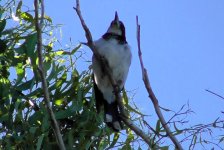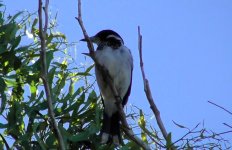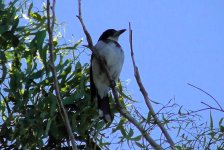I'm not sure you need to find an image exactly matching yours - given that the bird is clearly a butcherbird, and that only two species occur in SW Australia, it must be either pied or grey butcherbird. Given that only one of these has a black chest (in adult plumage), and that this species has a pale throat in immature plumage, it is presumably pied butcherbird, as Butty says, moulting into adult plumage. Butcherbirds have an intermediate immature plumage between juvenile plumage and adult, completing a full moult into adult plumage in their second year, at around the time of the adults' complete post-breeding moult - this would tie in with the timing of the photograph, as butcherbirds should be moulting at this time, as would the apparently fresh, adult-type tail feathers.
This sort of plumage pattern might only persist for a day or so, as feathers are quickly replaced and grow, and the transition from juvenile/immature to adult plumage can give rise to various unusual plumage patterns for brief periods - plus photographers, on the whole, don't tend to take/publish photographs of scruffy moulting birds, making examples hard to find online.
The only other clues are the location, which is better for grey butcherbird, as pied is pretty scarce that far south and west (though perhaps immature birds are more prone to wandering?), and the white tips to tail feathers, which to me look a bit better for the more restricted white on grey butcherbird (though as it is in moult, it may be that the outer feathers, which would show the most extensive white tips, are yet to grow - tail moult typically starting with the central pair and moving outward). All that being said, unless you can find evidence of a grey butcherbird showing a black chest, you're left with pied as the only real possibility.







